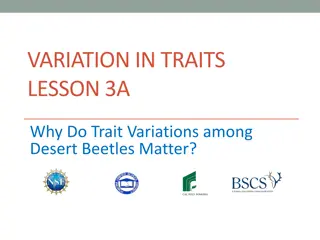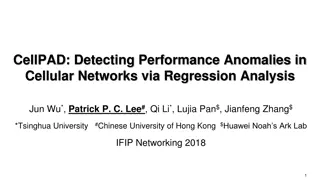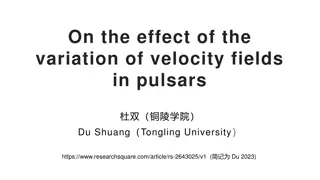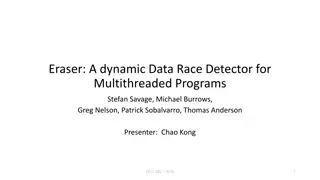Principal Components Analysis for Detecting Major Data Variations
Principal Components Analysis (PCA) is a powerful method for identifying significant directions of variation in data sets. It is particularly adept at revealing hidden structures like population subgroups with diverse allele frequencies and uncovering unexpected relationships or errors. By performing PCA on genotype data and forming a relatedness matrix, you can extract eigenvalues and eigenvectors to represent the variance along different directions in the data. Through examples and cautionary notes, this process helps control for sources of variation and aids in association testing. Utilize PCA to gain insights into your data's major variations and enhance your analytical capabilities effectively.
Download Presentation

Please find below an Image/Link to download the presentation.
The content on the website is provided AS IS for your information and personal use only. It may not be sold, licensed, or shared on other websites without obtaining consent from the author.If you encounter any issues during the download, it is possible that the publisher has removed the file from their server.
You are allowed to download the files provided on this website for personal or commercial use, subject to the condition that they are used lawfully. All files are the property of their respective owners.
The content on the website is provided AS IS for your information and personal use only. It may not be sold, licensed, or shared on other websites without obtaining consent from the author.
E N D
Presentation Transcript
Principal components analysis Gavin Band
Why do PCA? PCA is good at detecting directions of major variation in your data. This might be: Population structure subpopulations having different allele frequencies. Unexpected ( cryptic ) relationships. Artifacts such as genotyping errors, etc. Apart from intrinsic interest, these are precisely the factors that need to be controlled for in association tests.
Performing PCA 1. Take genotype data(*)... N samples L SNPs (*) Suitably normalised see later.
Performing PCA 1. Take genotype data(*)... 2. Form relatedness matrix N samples N samples L SNPs N samples rij = relatedness(*) between sample i and sample j. (*) With suitable normalisation: rij 1 if samples i and j are duplicates (or MZ twins) rij 0 if samples i and j are unrelated (relative to the sample.) (*) Suitably normalised see later.
Performing PCA 1. Take genotype data(*)... 2. Form relatedness matrix N samples N samples L SNPs N samples 3. Eigen-decompose it... Eigen-decomposition picks out directions in the data along which the variance is maximised. Eigenvalues represent the variance of the data along these directions. You can do this in R! E.g: > R = 1/L * (t(X) %*% X) > V = eigen(R)$vectors > plot( V[,1], V[,2] )
Example (Simulated data, N=50 individuals, L=1000 SNPs) Relatedness matrix R > R = (1/1000) %*% (t(X) * X)
Example (Simulated data, 50 individuals, 1000 SNPs) Eigenvectors Relatedness matrix R v1 v2 > V = eigen(R)$vectors
Example (Simulated data, 50 individuals, 1000 SNPs) Eigenvectors Relatedness matrix R v1 v2 > plot( V[,1], V[,2] )
Caution! PCA picks up any source of variation duplicate Pair of duplicate samples duplicate Badly genotyped sample Badly genotyped sample
Relatedness or why scale by f(1-f) At a SNP with frequency fin a base population. What is the probability of seeing these alleles in two haplotypes drawn from the population? INDIVIDUAL 2 Allele A Allele B frequency INDIVIDUAL 1 Allele A f Allele B 1-f f 1-f frequency
Relatedness or why scale by f(1-f) At a SNP with frequency fin a base population. What is the probability of seeing these alleles in two haplotypes drawn from the population? INDIVIDUAL 2 Allele A Allele B frequency INDIVIDUAL 1 Allele A f f2 f(1-f) Allele B 1-f (1-f)2 f(1-f) f 1-f frequency CORRELATION = 0 Unrelated individuals Alleles drawn independently
Relatedness or why scale by f(1-f) At a SNP with frequency fin a base population. What is the probability of seeing these alleles in two haplotypes drawn from the population? INDIVIDUAL 2 Allele 1 Allele 2 total INDIVIDUAL 1 Allele 1 f rf + (1-r)f2 (1-r)f(1-f) Allele 2 1-f r(1-f)+(1-r)(1-f)2 (1-r)f(1-f) f 1-f CORRELATION = r Individuals with relatedness r Alleles co-inherited identical by descent with probability r
Relatedness and population history a heuristic explanation Ancestral population Ancestral frequency = f Drift in allele frequency proportional to f(1-f) Drift in allele frequency proportional to f(1-f) Time Population 2 Population 1 SNP frequency f2= f + ?2 SNP frequency f1= f + ?1 ?? ? ?(1 ?) = the amount of drift in population i, similar across all variants So
Relatedness Or: mean centre rows of X and divide by standard deviation, and compute as before: Because f comes from the sample (not an ancestral population), rij is almost the same as a kinship coefficient, but is relative to the sample, not an ancestral population.
Association testing Without controlling for structure: Outcome ~ baseline + genotype Traditional approaches control for structure using a number of principal components.: Outcome ~ baseline + genotype + PC1 + PC2 + ... The most recent mixed model approach includes the whole relatedness matrix to control for structure: Outcome ~ baseline + genotype +
Association testing with linear mixed models Outcome ~ baseline + genotype + This is a bit like including all the PCs in a single regression, but constrained to explain a proportional amount of residual variation. In some circumstances it s been shown to control for structure better than using principal components directly. For example see Genetic risk and a primary role for cell-mediated immune mechanisms in multiple sclerosis , IMSGC & WTCCC2, Nature 2011. Or play with it at http://www.well.ox.ac.uk/wtccc2/ms. However these are linear models and some caveats remain in their use for case/control studies.
Summary PCA good at picking up sources of variation in datasets, including genetic datasets. Any form of variation can be picked up population structure, but also cohort or plate effects, genotyping error, sample duplication. This is what we want when controlling for structure / unwanted variation in an association test.
Software for performing PCA Plink (v1.9 or above) http://www.cog-genomics.org/plink2 EIGENSOFT http://genetics.med.harvard.edu/reich/Reich_Lab/Software.html Or use R!
Software for mixed model analysis GCTA http://genetics.med.harvard.edu/reich/Reich_Lab/Software.html FastLMM http://research.microsoft.com/en- us/um/redmond/projects/mscompbio/fastlmm/ MMM http://www.helsinki.fi/~mjxpirin/download.html GEMMA http://www.xzlab.org/software.html
Recommended reading Population Structure and Eigenanalysis , Patterson N, Price AL, Reich D, PLoS Genetics (2006). (The SmartPCA paper) Population Structure and Cryptic Relatedness in Genetic Association Studies , Astle W. and Balding DJ, Statistical Science (2009). "Reconciling the analysis of IBD and IBS in complex trait studies , Powell JE, Visscher PM, Goddard ME Nat. Rev. Genetics (2010). A Genealogical Interpretation of Principal Components Analysis , Gil McVean, PLoS Genetics (2009). Interpreting principal component analyses of spatial population genetic variation , John Novembre and Matthew Stephens, Nature Genetics (2008). Advantages and pitfalls in the application of mixed-model association methods , Yang et al, Nature Genetics (2014)



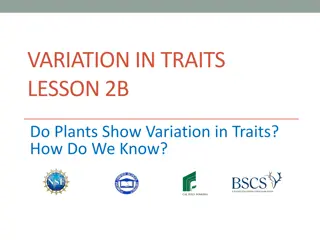


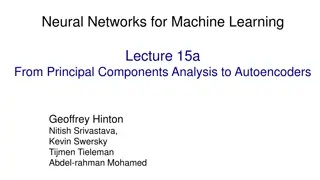



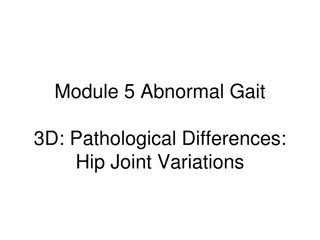


![Importance of Rock v. MWB [2018] UKSC 24 as Explained by Lord Sumption](/thumb/193348/importance-of-rock-v-mwb-2018-uksc-24-as-explained-by-lord-sumption.jpg)


